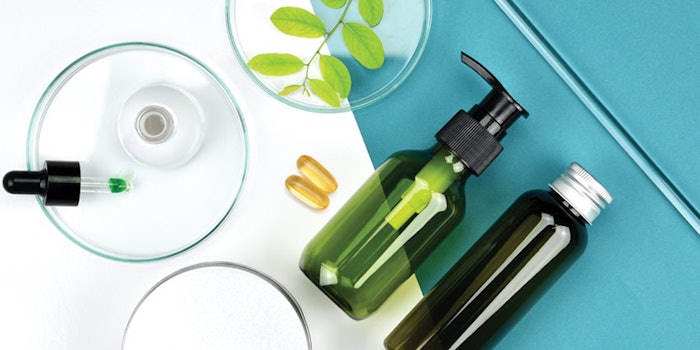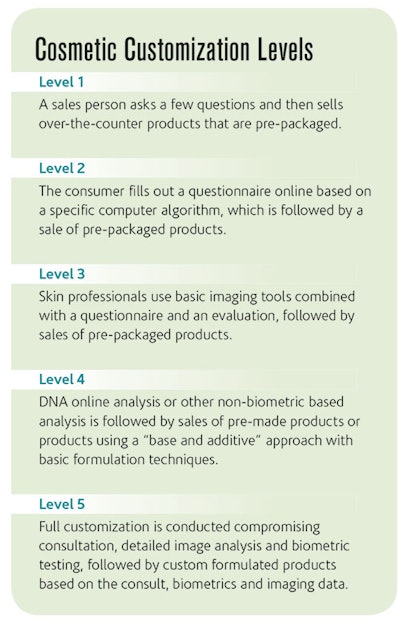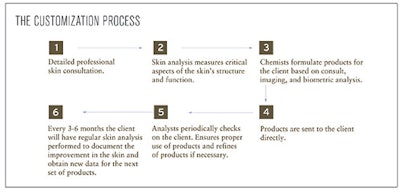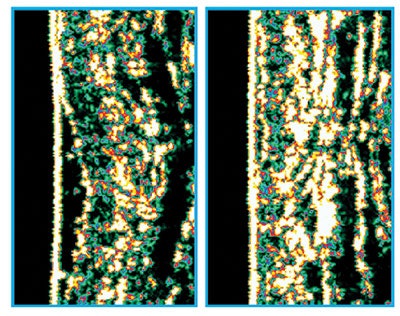
Customized, or personalized, cosmeceuticals are trending these days. Clinical skin care research in both skin analysis and cosmeceutical formulation has advanced to the point that it is now available directly to skin professionals and the public. The availability of these clinical skin care research techniques converging with the demand for truly customized, or personalized, cosmeceuticals have yielded novel ways for the client to obtain effective, customized skin care.
A recent Mintel study reported the following, “Consumers want products that fit their own personal routines and meet their own sensitivities. The beauty consumer is more than just a part of a demographic, a generation, or a gender—they are an individual.”1

Over 10 years ago, Proctor & Gamble launched an online customized skin care line where a questionnaire was completed, and products were customized in a manufacturing plant setting and sent to the customer. Around the same time there was the launch of one of the first DNA “customized” product lines, Lab 21. This model would take a DNA sample from a customer at retail, analyze the DNA and provide an analysis of the skin “markers” to prepare a personalized cosmeceutical to the customer. These products no longer are sold in the market.
Advertising is everywhere using these terms and describes customized products in different ways. There is not a well understood definition of customized or personalized skin care products or cosmeceuticals. The current products generally fall into the categories shown in Cosmetic Customization Levels. The majority of the current “customized” products or approaches are essentially selling pre-made products to the patient or client and forcing a fit that may or may not exist.
What are Customized Cosmeceuticals?
Let’s start with the basic definition of personalized or customized, which we will call customized from here on in this article.
Level 1. If you go to a retail beauty counter and ask one of the trained salespeople what you should use for your skin condition, they will provide you with a product that they have been trained to sell. Some call this customized since the trained salesperson selected the specific product based on the skin condition.
Level 2. The consumer fills out an online questionnaire on a website that then selects pre-made products. This is claimed to be a customized process, as the website offered a specific solution for the condition deduced from the consumer’s answers.
Level 3. The spa professional usually performs a skin analysis by touching the skin using a variety of techniques, asking questions, taking a bit of client history and possibly offering a wood’s lamp examination or even an image analysis. They make recommendations based on the pre-made products they carry.
Level 4. A physician’s consultation is usually the final step up the ladder of customizing cosmeceuticals, yet the process is quite similar. A medical consult is performed by the physician, nurse or other skin care professional; the use of image analysis can be included. Then, a pre-made product is prescribed whether it is a drug or a cosmeceutical. The “base and additive” model is sold in some outlets either online or at point-of-purchase. This semi- or partial-customization approach is helpful in some respects but lacks in true skin care customization.
Level 5. A more comprehensive customized approach (see The Customization Process) involves a multi-step clinical process, including the following:
- Detailed skin consultation;
- Image analysis in specific light conditions; and
- Biometric analysis including:
- a. Dermal ultrasound to determine the health of the dermal tissue,
- b. Trans-epidermal water loss (TEWL) measurement to determine barrier function,
- c. Sebum quantitative measurement to determine oil level,
- d. Elasticity measurement to determine the elastic or “bounce-back” aspect of skin,
- e. Hydration measurement to determine the stratum corneum moisture level of skin,
- f. Quantitative melanin concentration measure and
- g. Quantitative erythema measurement.

This entire analysis takes about 20 minutes. Cosmeceuticals are then custom formulated based on the information obtained above and sent to the patient completely customized. Follow-ups to the patient or client are made regularly thereafter to ensure satisfaction and efficacy.
Most of the customized selling models involve some type of interaction with the patient or client that ends up with a pre-made set of products being sold. Collecting a full set of validated biometrics is critical in solving the mystery of an individual’s skin.
The fully customized solution utilizes validated clinical instrumentation in combination with professionally trained consultation techniques to delve deeply into an individual’s history and skin anatomy and physiology to then develop a true skin solution for the individual.
Formulation in Customization
It is important to discuss briefly the formulation approach to this process. Once the consult, imaging and biometric analysis are complete, a cosmetic chemist interprets the data and formulates individual products for the specific patient. The Triple D concept of dose, delivery and depth is important here. First it is critical that the formulating chemist has a broad understanding of ingredients to make the proper selection from thousands of possible approaches, followed by the three Ds as outlined below.
Dose. How much of an ingredient should the client apply to the skin?
Depth. Where in the skin do we want this ingredient to go?
Delivery. How do we ensure that that ingredient, or set of ingredients, gets to the intended level in the skin?
The single term for this formulation approach is bioavailability. We must make the cosmeceutical bioavailable in the skin, otherwise they will not work.
Important: Barrier Function
Let’s take a look at the power of a true customization approach. In Ultrasound Before and After Below, ultrasound images are taken from a subject during a dermal ultrasound analysis of the skin. On the left side is the ultrasound image of a 32-year-old female. It is clear that the papillary dermis is intact with a low density of collagen. Also, the reticular layer is weak with a low density of elastin.

One of the most misunderstood yet most important aspect of biometric measurements is that of barrier function. Simply put, barrier function (see Barrier Function Below) is the skin’s ability to keep moisture in the skin and toxins out of the skin. When an individual’s skin has barrier impairment, a variety of symptoms can occur. A patient may complain that all the products that they are using cause their skin to burn or become irritated, while an acne prone patient may experience unexplained breakouts. Chronic barrier impairment may be misdiagnosed as rosacea or another skin condition. A simple way to understand this property of skin is to take a measure of TEWL, which will provide a measurement of barrier impairment.

Ingredient Selection
There are hundreds of ingredients that can be used to improve lipid production in skin, enhance the keratinocyte structure of skin and hydrate skin in combination to effectively manage a particular individual’s barrier function impairment. Barrier function impairment may take many different forms in different individuals. This is in the hands of experienced chemists who can interpret the data and provide the optimal solution for each person.
There are many more properties, including sebum levels, moisture levels, pH, melanin levels, erythema (inflammation) and others that need to be managed to optimize one individual’s skin.
Within Reach
While this all sounds like a complex approach, it is actually simple, takes little time to perform and is non-invasive for the patient or client. This is the essence of the art and science of true skin customization and advanced cosmeceutical research. The future is here, and these techniques of customization that are so highly sought after are now available and easily obtained on the market today.
References
- Mintel Global Trends Report 2018, www.mintel.com/beauty-trends/












